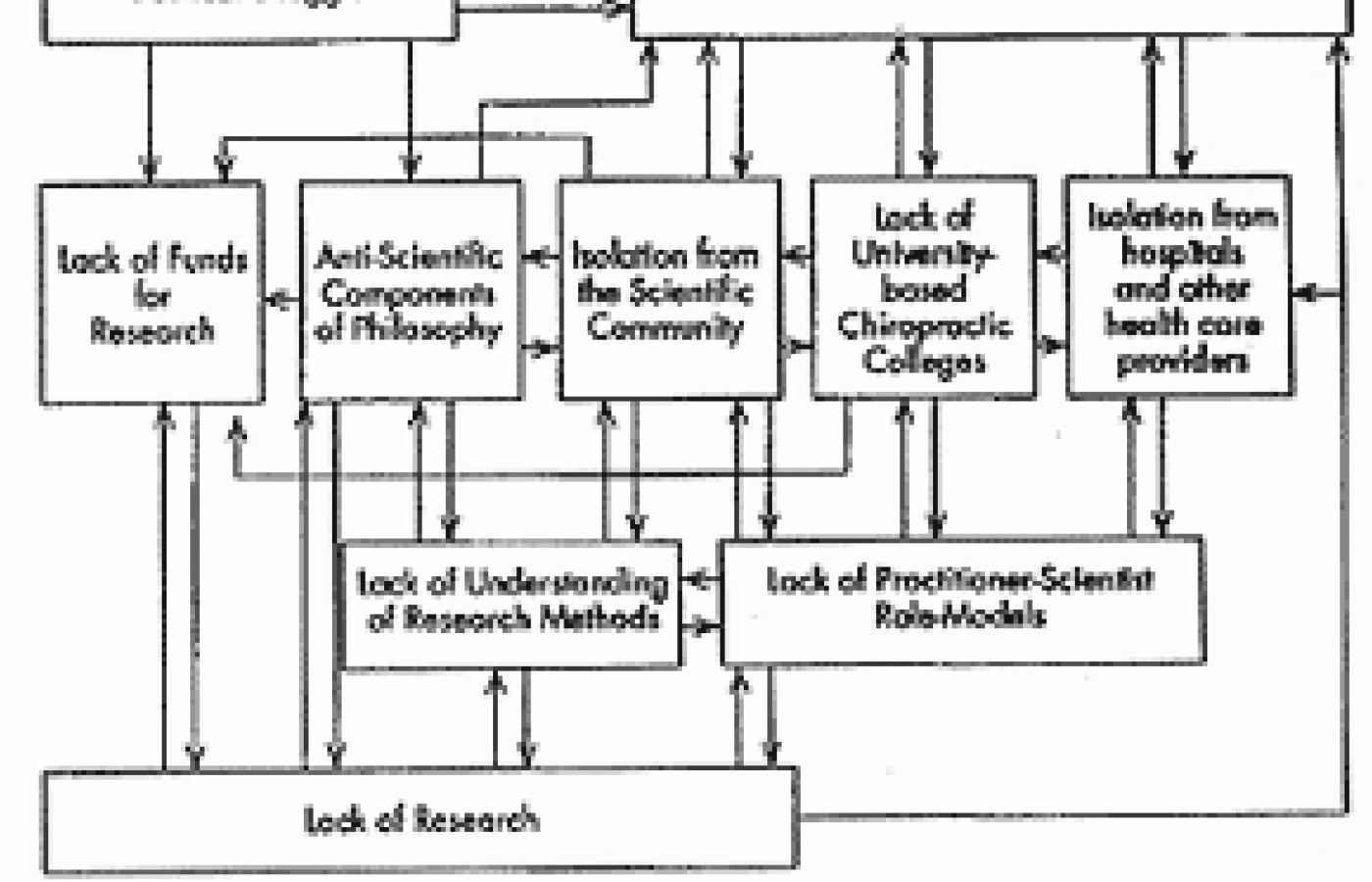Recent laws in New Jersey and California represent a disturbing trend that will negatively impact a practice’s ability to collect monies from patients, as well as expose them to significant penalties if the practice does not follow the mandatory guidelines to a T. Please be aware that a similar law may be coming to your state. The time to act is before the law is passed.
Forecasting Chiropractic: Health Care in the 21st Century
The Delphi Panel
Recently, while in residence at the Texas Back Institute (TBI), I was asked to review of a recent issue of Topics in Clinical Chiropractic (TICC) for Daniel Hansen,DC, an associate editor to the journal. TICC is an excellent peer-reviewed journal for clinicians and students who want to stay abreast of the most recent developments. This high-quality journal tackles specific topics, ranging from the basic and clinical sciences to issues that affect every chiropractor in today's health care environment.
In the March 20001 issue, the topic selected was "Health Care in the 21st Century." Rather than putting together a journal with its usual informative content, the editors used the March issue as an exercise in forecasting trends in health care. There are many ways that experts in various industrial and health care fields look to the future for information. These methods are thoroughly examined in the first article by Dr. Hansen. For this exercise, the authors used the Delphi method. In this process, 16 topics were selected, and 16 voting panelists were matched for their expertise. A 30-question survey was then developed discussing these various issues in chiropractic:education and credentialing; accountability in the delivery of chiropractic care; social and ethical conflicts; economic trends; health benefit constructs; and hypotheses of the vertebral subluxation. The survey was conducted using the 16 appointed experts, and then mailed back. The experts were asked to write manuscripts in their areas of expertise before being surveyed again on the same questions.
This exercise raised some of the most important issues facing chiropractic today. Virtually almost all of the 16 authors discussed issues such as evidence-based practice; outcomes assessment; supply and demand of chiropractors; interdisciplinary and multidisciplinary training; university affiliation; and managed care. This exercise did not plan for specific actions on how to accomplish these important issues facing chiropractic. Instead, the authors engaged the reader to begin to think about where this profession needs to go and how we might get there.
The State of Chiropractic Colleges
When evaluating chiropractic education, Reed Phillips,DC,PhD, raised many important issues facing our colleges. There has never been to this date a formal "manpower" study of the need for chiropractic. Are we saturating the market with chiropractors? This may be a difficult question to answer given the lack of definition our profession has. Dr. Phillips continued to suggest that we may need to consider the consolidation of the 16 schools and consider university affiliation to lessen the financial burden on our institutions.
Dr. Phillips and fellow panelist Jacqueline Bougie,DC, concluded the current chiropractic training needs improvement. Phillips suggested a longer clinical internship with a high volume of relevant patients. Residency programs could help aid in the development of practitioner-scientist roles.
Throughout this issue, many authors pointed to the fact that chiropractic college clinics are not recognized, developed or marketed as centers of excellence. For example, if a chiropractic college clinic was developed to serve as a condition-centered specialty clinic for musculoskeletal conditions, patients with more relevant and severe cases would present to the clinic and enhance the clinical experience for interns.
The clinical experience in chiropractic college is on average 1,405 hours. Medical students receive an average of 3,467 hours of clinical training. Medical students are typically exposed to a wide variety of cases preparing them for the future. In a chiropractic clinic, an intern may go the entire year without being exposed to complex cases and an overabundance of asymptomatic patients. Both authors recommend a postgraduate residency or internship to continue to develop skills and gain confidence as a doctor of chiropractic.
Advanced clinical training in chiropractic is long overdue. Only a few chiropractic colleges offer residency programs, but they are not a requirement such as in medicine, and therefore there is very little incentive to pursue this path. Moreover, it is unlikely that unless chiropractic colleges gain access to specialty centers (e.g., Texas Back Institute) or affiliate with established universities, expanding residency programs may be a difficult task. With the recent addition of a chiropractic college at Florida State University, more advanced clinical training may be available to serve as a model for the rest of the profession.2
What Direction Chiropractic?
Palmer University professor Cheryl Hawk,DC,PhD, examined chiropractic as a "Wellness" profession. Is this the direction the chiropractic profession should go? Chiropractic contains many of the ideals that make it a profession that is compatible with prevention, wellness and health promotion. Maintenance care has long been considered a part of chiropractic health and wellness and been marketed to patients for health benefits. However, Dr. Hawk acknowledged the lack of scientific evidence surrounding this philosophy. She argued that there must be longitudinal, population-based studies to test this hypothesis. Maintenance care does not necessarily make chiropractic a wellness care profession. There is very little evidence that maintenance care prevents disease. The evidence is simply not there now to support this hypothesis. It is also discussed that if chiropractic wanted to truly define itself as a profession of "wellness," than chiropractic education would have to vastly expand its knowledge in this area. The large base of evidence on prevention and health promotion methods and measures would have to be included in educational training.

Disciplinary Education
One issue that virtually every expert surveyed agreed upon was the lack of interdisciplinary or multidisciplinary education in chiropractic. Are chiropractors prepared to integrate with other health professions? Most experts agreed that there is virtually no preparation for chiropractors to easily integrate with mainstream health care providers. Figure 1 (below) illustrates some of the barriers that have limited chiropractic from integrating with the rest of the health care community.
I have firsthand experience in the area of interdisciplinary education, and appreciate the importance of learning about other disciplines and how to work more closely with these professionals. At my institution, I co-founded an organization whose primary goal was interdisciplinary education of chiropractic students. Through seminars, guest speakers and campus club meetings, our goal was to take the mystery out of other disciplines and begin to prepare students for these future collaborations. We only touched the surface with our efforts. If chiropractic is to integrate our practices with other health care professionals, we will have to alter current chiropractic curriculum.
Unfortunately, there is simply not enough time to train chiropractors as comprehensive wellness and/or musculoskeletal doctors in a four-year program. Once again, residencies could aid in developing these skill sets. It is unlikely that the chiropractic profession will agree on one definition for our profession and therefore, I propose required residencies in wellness care and musculoskeletal care upon completion of the DC degree. This would enable students to choose an area of interest and continue to develop skills in their specialty.
Similar conclusions were reached by John Triano,DC,PhD, of TBI. If chiropractors are to assume roles in interdisciplinary groups working with more severe clinical populations, more advanced training will have to be available beyond the current entry level status. He also concludes that if we wish to be identified as primary care physicians, nonmusculoskeletal clinical training will have to increase.
Dr. Triano also called for more "cross-training" of chiropractors, if only for spine care. Programs need to be implemented that will enable chiropractors to more easily continue their education in areas such as academia, research, industry, and government agency. Creating dual degree programs (by affiliating with universities) like "DC/MPH" or "DC/PhD" would allow for more chiropractors to pursue career tracks in research and policy.
DC Debts
Chiropractors in 2000 still face many obstacles involving various trade associations, research organizations, and other membership groups. George McClelland,DC, pointed to escalating costs of chiropractic education, which I know all too well. He states, "New DC's seek quick money to ease their debts and therefore, are often forced toward more marginal patient recruitment practices and the gurus that teach these methods. New DCs are turned away from the research-based, outcomes-driven, patient-centered paradigms they were taught, toward a market focus (i.e., to get more patients in the door). This in turn creates negative images for the profession in the eyes of the general public, policymakers, and other providers. Still, there is an increasing number of new DC failures and debt defaults." Dr. McClelland also makes light of an important issue raised earlier. There are no "centers of clinical excellence" currently within the chiropractic profession. Possibly by developing and integrating into these types of centers, new graduates would be less likely to enter into marginal practices and default on their loans.
New graduates also enter a health care marketplace where they are restricted from managed care panels typically for three to five years. This may continue to make practice and debt repayment for new graduates more difficult, considering most of U.S. health services are now "managed" in some way. This also perpetuates marginal practice methods, as discussed previously. Donald Peterson's article previously published in this publication addressed many of these managed care issues.
Can't We All Just Get Along?
Panelist David Chapman-Smith, LLB (Hon), examined many of the clinical and nonclinical motivations in chiropractic practice. One interesting issue mentioned was criticism of other health care professionals. During my training in chiropractic I heard numerous field chiropractors, faculty, and students make unnecessary criticism of medical doctors. Does this make us feel better about who we are? Are we insecure as chiropractors? I believe this unprofessional behavior must come to an end. Chapman-Smith also notes that chiropractors are often engaged in withholding a treatment or referral to another practitioner, chiropractic or otherwise, because it does not agree with their belief systems. (If a patient would benefit from a type of surgery or some active rehabilitation, isn't it in the best interest of the patient to make a referral?) In addition, he concluded, "the traditional chiropractic-centered and isolationist approach to chiropractic practice will not succeed in the future."
A Template for Tomorrow
Other articles by authors such as Pran Manga,PhD, Dana Lawrence, DC, James Dillard,MD,DC,CAc, R. Douglas Metz,DC, William Meeker, DC,MPH,FICC, Edward Owens, MS,DC, Karen Terwilleger, JD,MES, and Russell Coile Jr., are excellent and certainly worthy for review.
These authors are to be commended for their insight into our accomplishments and the challenges we face today and tomorrow. Exercises such as this in TICC are crucial to identify our strengths and weaknesses and focus on new strategies for tomorrow. Students and field doctors need to listen to our leaders and work together planning for our future. Forecasting methods such as this need to be used as a template and must evolve into actual strategies that our profession can implement. As Joseph Keating Jr., PhD, once wrote, "We have a ways to go."
Darrell Bruga,DC
Los Gatos, CA
References
- Topics in Clinical Chiropractic. March 2000; 7(1): 1-89
- Chiropractic College Coming to Florida State University. Dynamic Chiropractic. June 26, 2000; 18(14): 1, 14. http://www.chiroweb.com/states/florida.html



